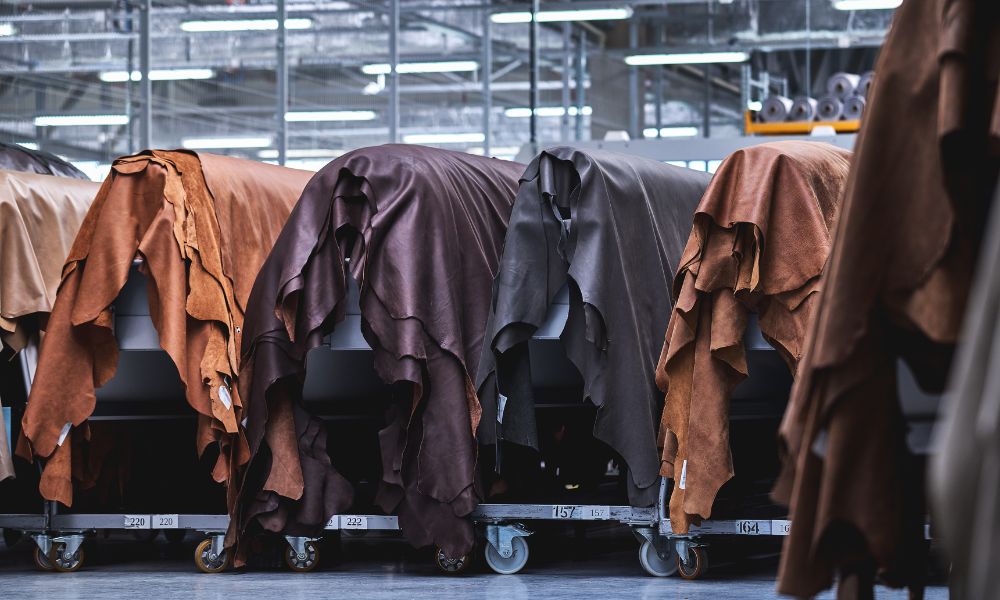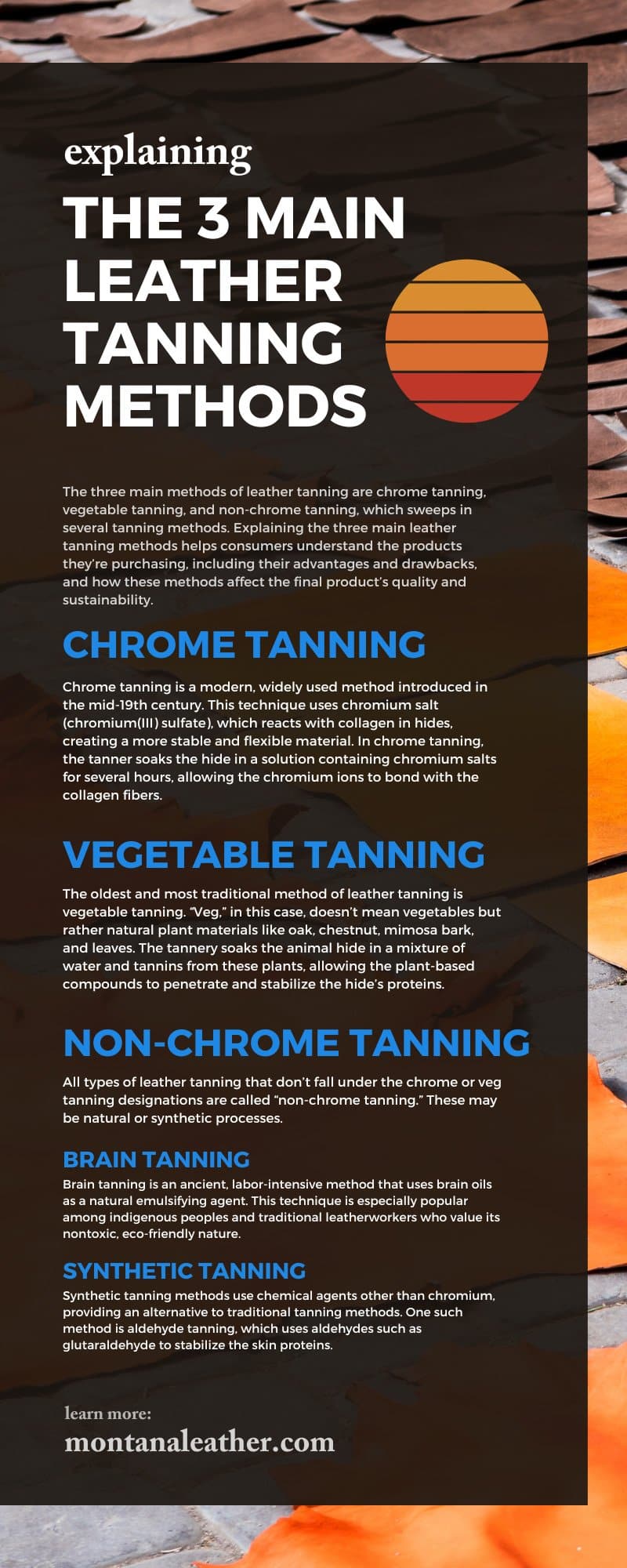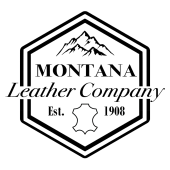
Humans have been processing leather for millennia using a variety of techniques, some of which are still in use today. Leather tanning prevents putrefaction of animal hides while preserving and enhancing their natural properties. Tanning makes leather more durable, flexible, and soft—the kind of leather consumers value in high-quality products such as shoes, bags, furniture, and more.
The three main methods of leather tanning are chrome tanning, vegetable tanning, and non-chrome tanning, which sweeps in several tanning methods. Explaining the three main leather tanning methods helps consumers understand the products they’re purchasing, including their advantages and drawbacks, and how these methods affect the final product’s quality and sustainability.
Preparing Hides for Tanning
Regardless of the tanning method a leather maker uses, there are several preparation methods that all leather tanning processes have in common. These steps include removing any hair, fats, and tissue from the animal hide, as well as cleaning and washing the hide to remove any dirt or debris. These preparatory steps are essential to ensure the tanning solution can penetrate the hide’s fibers to create a durable and long-lasting leather material.
Once the hide is properly cleaned and prepped, the tanner can treat it with a tanning solution that imbues it with the desired texture, suppleness, and water resistance. Tanning may produce a color that’s just what the leather goods maker needs, or the producer can dye the leather to produce a different color to meet a different need.
Chrome Tanning
Chrome tanning is a modern, widely used method introduced in the mid-19th century. This technique uses chromium salt (chromium(III) sulfate), which reacts with collagen in hides, creating a more stable and flexible material.
How Chrome Tanning Works
In chrome tanning, the tanner soaks the hide in a solution containing chromium salts for several hours, allowing the chromium ions to bond with the collagen fibers. When the hide has soaked for long enough, it’s washed, rehydrated, and dried, leaving a soft, supple leather material.
Advantages and Drawbacks
Chrome tanning is fast and efficient, taking as little as one day to complete. This method produces a wide range of vibrant colors and finishes as well as leather that is more water-resistant and less susceptible to stains. However, chrome tanning faces criticisms due to its environmental impact. Chromium(III) salts aren’t toxic to humans in low doses. However, chromium(III) can transform into toxic chromium(VI) (hexavalent chromium) with exposure to heat, sunlight, oxygen, or oils and waxes used in finishing the leather. Those most at risk are leather workers involved in the tanning process. Careless dumping of chrome tanning waste can introduce toxins to the environment.
Vegetable Tanning
The oldest and most traditional method of leather tanning is vegetable tanning. “Veg,” in this case, doesn’t mean vegetables but rather natural plant materials like oak, chestnut, mimosa bark, and leaves. The tannery soaks the animal hide in a mixture of water and tannins from these plants, allowing the plant-based compounds to penetrate and stabilize the hide’s proteins.
How Vegetable Tanning Works
During vegetable tanning, the tannery treats prepared hides with tannin-rich solutions, starting with weaker concentrations and gradually increasing in strength. This process can take between 30 and 60 days, depending on the desired suppleness and thickness of the finished leather.
Advantages and Drawbacks
Veg tan leather supplies are produced from natural, plant-based ingredients. This process results in high-quality leather with a distinct appearance and smell, which tends to develop a deep, natural patina over time. The method is useful for producing thicker leather that’s well suited to belts, saddles, and bags that don’t collapse. However, vegetable-tanned leather can be less resistant to water than leather tanned with other tanning methods.
Non-Chrome Tanning
All types of leather tanning that don’t fall under the chrome or veg tanning designations are called “non-chrome tanning.” These may be natural or synthetic processes.
Brain Tanning
Brain tanning is an ancient, labor-intensive method that uses brain oils as a natural emulsifying agent. This technique is especially popular among indigenous peoples and traditional leatherworkers who value its nontoxic, eco-friendly nature.
Hunters may use brain tanning to preserve hides from game. After cleaning and scraping to remove hair, flesh, and fat, the tanner mixes the brain of the animal with water to create an emulsion. They then apply the mixture to the hide before working it over a wooden frame or a smooth log.
Advantages and Drawbacks
Brain tanning produces soft and pliable leather that is less stiff than other types of leather. Other animal-fat-rich substances used in tanning include fish oil, marrow, egg yolk, and yak butter. The process can take several days, as the worker must stretch the leather repeatedly until it reaches the desired softness and suppleness.
Synthetic Tanning
Synthetic tanning methods use chemical agents other than chromium, providing an alternative to traditional tanning methods. One such method is aldehyde tanning, which uses aldehydes such as glutaraldehyde to stabilize the skin proteins.
Advantages and Drawbacks
Synthetic tanning creates leather that is highly resistant to water and heat. This method produces leather that is consistent in color and texture while also being resistant to wear and tear.
However, synthetic tanning methods are known for harsh chemicals and toxic substances that can be hazardous to both the environment and human health. Synthetic tanning methods can contribute to soil and groundwater contamination, which can have severe long-term effects on both the environment and public health. Synthetic tanning methods can take longer to achieve the desired results than traditional chromium tanning methods.
Leather tanning is an ancient craft that has evolved to produce a wide range of high-quality leather products that we use and love. The three main leather tanning methods all have advantages and drawbacks.
Leather goods makers who buy tanned hides in bulk to produce clothing and furniture, and artisans who craft unique items from wallets to saddles understand tanning and its implications. Leather goods makers, artisans, and consumers should carefully select a responsible and experienced leather supplier like Montana Leather Company. When they do so, they can make informed choices about the types of leather they want to use or purchase.


